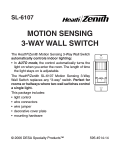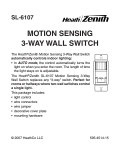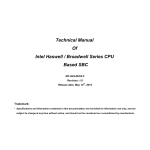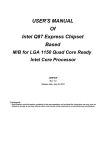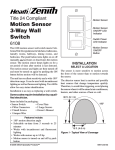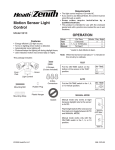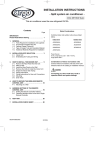Download Heath Zenith SL-6107 User's Manual
Transcript
SL-6107 MOTION SENSING 3-WAY WALL SWITCH The Heath®/Zenith Motion Sensing 3-Way Wall Switch automatically controls indoor lighting: • In AUTO mode, the control automatically turns the light on when you enter the room. The length of time the light stays on is adjustable. The Heath®/Zenith SL-6107 Motion Sensing 3-Way Wall Switch replaces any “3-way” switch. Perfect for rooms or hallways where two wall switches control a single light. This package includes: • light control • wire connectors • wire jumper • decorative cover plate • mounting hardware © 2003 DESA Specialty Products™ OFF AUTO ON 595-4514-13 Some local building codes may require installation by a qualified electrician. INSTALLATION ❐ For your safety, turn off power at the fuse or circuit breaker. Note: A “3-way” circuit controls lights from two separate switches. If you want to use this product in a single switch circuit or if you want to install more than one motion sensing wall switch, see Special Installations, page 8. ❐ Select a 3-way circuit that controls a light or an outlet to a lamp. Total lighting must be from 25 to 500 watts incandescent, or 60 to 400 watts fluorescent using a rapid start ballast. Note: May not be used to operate electronic or magnetic ballasts. Less wattage than the minimum may not allow the control to work properly. The switch selected for replacement should be in a place that can detect motion in the desired area. ✓ For easier re-wiring later, mark the house wiring with tape indicating where the wire had been connected. In the following section you will install a jumper wire at one 3-way switch and replace the other switch with the SL-6107. *Note: The existing 3-way switch will be referred to as the “Remote Switch” throughout the rest of the installation manual. -2- 595-4514-13 INSTALLATION See pages 4 through 6 for detailed instructions for installing and wiring the SL-6107 Wall Switch. EXISTING LIGHT SWITCH CONFIGURATION WHITE FROM POWER SOURCE WHITE WHITE *COMMON BLACK *COMMON RED (In Wall) BLACK BLACK SL-6107 SWITCH 1ST ON CIRCUIT WHITE WHITE WHITE FROM POWER SOURCE ADD JUMPER WIRE *COMMON BLACK BLACK BROWN OFF AUTO RED (In Wall) ON RED (From 6107) SL-6107 BLACK BLACK EXISTING 3-WAY SWITCH SL-6107 SWITCH 2ND ON CIRCUIT WHITE WHITE WHITE FROM POWER SOURCE ADD JUMPER WIRE BLACK *COMMON RED (In Wall) BROWN BLACK RED (From 6107) BLACK OFF EXISTING 3-WAY SWITCH AUTO ON BLACK SL-6107 *COMMON-Used for illustrative Purposes Only. Check Your Switch. The common may be in a different location, depending on the brand of your switch. RED is used to represent the second wire between two standard three-way switches. This may not be the color used in all installation. If you are not sure about your wiring, call an electrician for installation help. There is also a RED wire on the SL-6107 switch. Check the instructions above closely and do not confuse the two. 595-4514-13 -3- INSTALLATION 1. Add Jumper At Remote 3-Way Switch. A jumper wire between the common wire and one of the switched wires is used to supply power to the SL-6107 regardless of the position of the remote switch. ❐ Remove remote switch from the junction box. The switch may indicate the common Common Switch Lug COMMON Hot Wire OR Jumper Color of screw may be different for the common To brown wire of SL-6107 (note color) To Red wire of SL-6107 (note color) Connect Jumper at the Remote Switch ❐ Connect the jumper wire to the common lug (usually labeled on the switch) and to either one of the two switched lugs. If you're not sure which lug is common, install the jumper on any two of the wires, and test the jumper as explained on the next page. -4- 595-4514-13 INSTALLATION 2. Replace Other Switch. ❐ Turn the power off at the circuit breaker. ❐ Remove and disconnect the old switch. Note: If you can't tell which wire is common, etc., connect the wires in the following steps as best you can, then follow the test on the next page. ❐ Connect the black motion sensor wire to the common wire. ❐ Connect the brown motion sensor wire to the jumpered wire on the remote switch. ❐ Connect the red motion sensor wire to the non-jumpered wire. ❐ Connect the green motion sensor wire to the ground wire. Jumpered Wire Brown Non-Jumpered Red Wire Removed from Common OFF Ground Wire (Green or Bare Wire) Green Black Connect the SL-6107 to Existing Wiring 595-4514-13 -5- AUTO ON INSTALLATION Test For Correct Common Wire Connection: Re-install the switch. Turn the circuit breaker back on. Leaving the jumpered switch in one position, flip the other 3-way switch on and off. Lights turn on and off. Yes Jumper is correct. Go to next page. No Flip the switch with the jumper wire to the other position. Move one end of the jumper wire to the previously unconnected terminal. Flip the unjumpered switch on and off. Remove the jumpered switch from the junction box. Turn the power off at the circuit breaker. No Lights turn on and off. -6- Yes Jumper is correct. Go to next page. 595-4514-13 INSTALLATION ❐ Mount the SL-6107 into the junction box with the two junction box screws. ❐ Turn the circuit breaker back on. ❐ Preset the controls: Time to min. (fully counter-clockwise), Photo Adjustment fully clockwise. Cover the lens with masking tape. ❐ With the motion sensor in the “ON” position, turn the remote switch on and off several times. Go to step 1, 2, or 3, depending on results. Troubleshooting Wiring Connections * Turn power off before rewiring! 1. If light does not turn on: 2. If light turns on in only one position of remote switch: 3. If light turns on with remote switch in either position: ➯ Exchange* Control's Red ⇔ Black wires. ➯ Test again. Go to 2 or 3. ➯ Exchange* Control's Red ⇔ Brown wires. ➯ Test again. Go to 1 or 3. ➯ Set sensor to “AUTO”. Wait for the unit to warm up (up to 1 min.). If the remote switch can turn the lights on, it's OK. Otherwise: ➯ Exchange* Control's Black ⇔ Brown wires. Remove the tape. Go to the next page. 595-4514-13 -7- SPECIAL INSTALLATIONS For single switch installations, connect the wall switch as shown here. SINGLE SWITCH INSTALLATION BLACK BROWN BLACK FROM POWER SOURCE OFF ON AUTO BLACK RED SL-6107 WHITE If you want to have motion sensors at both 3-way switches, connect them as shown below. The minimum wattage may increase to 100 W for fluorescent and 50 W for incandescent lighting. WHITE EXISTING LIGHT SWITCH CONFIGURATION WHITE FROM POWER SOURCE BLACK WHITE *COMMON WHITE *COMMON RED (In Wall) BLACK BLACK 2 SWITCH INSTALLATION FROM WHITE POWER SOURCE WHITE BROWN WHITE BROWN BLACK BLACK BLACK RED (From 6107) OFF AUTO OFF ON SL-6107 RED (From 6107) AUTO ON BLACK SL-6107 RED (In Wall) *COMMON-Used for illustrative Purposes Only. Check Your Switch. The common may be in a different location, depending on the brand of your switch. RED is used to represent the second wire between two standard three-way switches. This may not be the color used in all installation. If you are not sure about your wiring, call an electrician for installation help. There is also a RED wire on the SL-6107 switch. Check the instructions above closely and do not confuse the two. -8- 595-4514-13 ADJUSTMENT PHOTO SENSITIVITY 20 Minutes Any Light Level ON OFF + AUTO Press in with screwdriver. Swing out cover to remove. TIME Dark + LIGHT 5 Seconds The sensor can be prevented from turning on lights when there is already enough light in the room. Use a small screwdriver to set the light level using this diagram as a guide. In the fully clockwise position, the sensor turns on lights even in full daylight. In the fully counter-clockwise position, the sensor only turns on lights when the surrounding light level is very low. ❐ With the switch in the AUTO position and the light at the desired level for the lights to turn on, put the LIGHT control to the minimum dark (fully counter-clockwise) position. Wait for the lights to turn off. ❐ Move your hand in front of the sensor. While moving your hand in front of the sensor, slowly turn the LIGHT adjustment clockwise until the lights controlled by the sensor come on. 595-4514-13 -9- ADJUSTMENT TIME CONTROL The time control sets how long the light stays on after motion is detected or the remote switch is flipped. ❐ Turn the control clockwise to 20 Minutes 5 Seconds increase the time up to about 20 minutes. ❐ Turn the control counter-clockwise to decrease the time to about 5 seconds. Use a small screwdriver to set the control. + INSTALL WALL COVER PLATE ❐ Secure the included wall plate with the screws provided. AUTO ON OFF Outlet Cover Plate -10- 595-4514-13 OPERATIONS USING THE LIGHT CONTROL One of three functions can be selected by using the three-position switch on the SL-6107: Off: When you want the light off all the time. The light will not be switched on by either switch. Put the control in this position when changing light bulbs. Auto: When you want the light to come on and turn off automatically with motion or turn on with remote switch. The control will switch the light on when motion is detected. If no further motion is detected, the light will turn off after the pre-set time period. To turn the light on again, move in the detection zone. Flipping the remote switch up or down will turn the light on for the pre-set time period. On: When you want the light on all the time. In this position, the light will remain on all the time, daytime and night. Flipping the remote switch will not affect the light. The Photo shut-off is also inactive. 595-4514-13 -11- TROUBLESHOOTING Light will not come on: • Circuit breaker is off. Turn breaker back on. • Bulb is burned out. Replace light bulb. • Photo Sensitivity is set to DARK. Rotate the adjustment clockwise towards the LIGHT position. • Control is in the “Off” position. Set to Auto or On. • Control may be wired incorrectly. See Troubleshooting Wiring Connections, page 7. Light will not turn off: • Control is in the “On” position. Set to Auto or Off. • Control time period set too long. Set to shorter time period. • Control may be wired incorrectly. See Troubleshooting Wiring Connections, page 7. Remote switch does not work: • The remote switch only works to turn the light on in the Auto mode. Put sensor in the Auto mode. • Control may be wired incorrectly. See Troubleshooting Wiring Connections, page 7. In Auto mode, light comes on randomly: • Objects in detection area which heat and cool, such as air vents or appliances, may trigger the control. Also, check wiring. See Troubleshooting Wiring Connections, page 7. • The remote switch may have been flipped on. In the Auto mode, light does not turn on: • If there is too much light already in the room, the light may not come on. Turn the Photo control clockwise towards the any light level position. -12- 595-4514-13 TROUBLESHOOTING In the Auto mode, light does not stay on: • Motion is needed to keep the light on. • Time control is adjusted for too little time. Turn the Time control clockwise. Note: In the minimum time position, fluorescent lights may not have enough time to turn on. In the Auto mode, light turns on in daylight: • Photo adjustment not set properly. Turn the Photo control counterclockwise towards the DARK position. TECHNICAL SERVICE (Do Not Send Products) If you experience a problem, follow this guide. You may also want to visit our Web site at: www.desatech.com. If the problem persists, call* for assistance at 1-800-858-8501, 7:30 AM to 4:30 PM CST (M-F). You may also write* to: DESA Specialty Products™ P.O. Box 90004, Bowling Green, KY 42102-9004 ATTN: Technical Service Specialty Products * If contacting Technical Service, please have the following information available: Model Number, Date of Purchase, and Place of Purchase. No Service Parts Available for this Product 595-4514-13 -13- SPECIFICATIONS This product is to be installed indoors only. Electrical Input .......................................................... 120V, 60 Hz. Fluorescent* Load ...................................... (2) 30 Watt minimum, Up to 400 Watts Maximum Rapid Start Ballast Motor Load ............................................... Up to 1/8 HP Maximum Incandescent .................................... Up to 500 Watts at 120VAC On-Time .................... Adjustable approximately 5 sec. to 20 min. Photocell Sensor ................. From full daylight to less than 1 FC. Coverage ........................................... up to 15 ft. (4.6 m) at 150°, up to 30 ft. (9.1 m) in front of the sensor Specification subject to change without notice. *Designed for use with standard 3 ft./30 watt and 4 ft./40 watt rapidstart fluorescent tubes. Not designed for use with compact fluorescent bulbs. Minimum of two tubes required. Note: May not be used to operate electronic or magnetic ballasts. DESA Specialty Products™ reserves the right to discontinue products and to change specifications at any time without incurring any obligation to incorporate new features in previously sold products. -14- 595-4514-13 FIVE YEAR LIMITED WARRANTY This is a “Limited Warranty” which gives you specific legal rights. You may also have other rights which vary from state to state or province to province. For a period of five years from the date of purchase, any malfunction caused by factory defective parts or workmanship will be corrected at no charge to you. Light bulbs are not covered. To obtain a refund or a replacement, return the product to the place of purchase. Not Covered - Repair service, adjustment and calibration due to misuse, abuse or negligence, light bulbs and other expendable items are not covered by this warranty. Unauthorized service or modification of the product or of any furnished component will void this warranty in its entirety. This warranty does not include reimbursement for inconvenience, installation, setup time, loss of use, or unauthorized service. This warranty covers only DESA Specialty Products™ assembled products and is not extended to other equipment and components that a customer uses in conjunction with our products. THIS WARRANTY IS EXPRESSLY IN LIEU OF ALL OTHER WARRANTIES, EXPRESS OR IMPLIED, INCLUDING ANY WARRANTY, REPRESENTATION OR CONDITION OF MERCHANT ABILITY OR THAT THE PRODUCTS ARE FIT FOR ANY PARTICULAR PURPOSE OR USE, AND SPECIFICALLY IN LIEU OF ALL SPECIAL, INDIRECT, INCIDENTAL, OR CONSEQUENTIAL DAMAGES. REPAIR OR REPLACEMENT SHALL BE THE SOLE REMEDY OF THE CUSTOMER AND THERE SHALL BE NO LIABILITY ON THE PART OF DESA SPECIALTY PRODUCTS™ FOR ANY SPECIAL, INDIRECT, INCIDENTAL, OR CONSEQUENTIAL DAMAGES, INCLUDING BUT NOT LIMITED TO ANY LOSS OF BUSINESS OR PROFITS, WHETHER OR NOT FORESEEABLE. Some states or provinces do not allow the exclusion or limitation of incidental or consequential damages, so the above limitation or exclusion may not apply to you. Retain receipt for warranty claims. 595-4514-13 -15- SL-6107 INTERRUPTOR TRIDIRECCIONAL DE PARED Y DECTECTOR DE MOVIMIENTO El Interruptor Tridireccional de pared y Dectector de Movimiento controla automáticamente la iluminación interna: • En la modalidad de AUTO, el control automáticamente prende la luz cuando usted entra al cuarto. El período de tiempo que la luz se queda prendida es ajustable. El Interruptor Tridireccional de pared y Dectector de Movimiento SL-6107 reemplaza a cualquier interruptor tridireccional. Perfecto para cuartos o pasillos donde dos interruptores de pared controlan una sola luz. Este paquete tiene: • el control de luz • los conectores de alambre • los cables de puente • la placa cubertora decorativa • los herrajes de montaje OFF © 2003 DESA Specialty Products™ -16- AUTO ON 595-4514-13 595-4514-13 S Algunos códigos locales de construcción pueden requerir que la instalación sea hecha por un electricista calificado. INSTALACION ❐ Para su seguridad, apague la energía en el fusible o en el cortacircuitos. Nota: un circuito “tridireccional” es un circuito de luz controlado desde dos interruptores separados. Si desea usar este producto con un circuito de un solo interruptor vea Instalaciones Especiales, página 23. ❐ Escoja un circuito de 3 direcciones que controle una luz o un enchufe de lámpara. El alumbrado total debe estar entre 25 a 500 vatios incandescentes, o entre 60 a 400 vatios fluorescentes usando un estabilizador de arranque rápido. Nota: Puede que no se use para hacer funcionar estabilizadores electrónicos o magnéticos. Un vatiaje menor del mínimo no permitirá que el control funcione correctamente. El interruptor seleccionado para cambiar debería estar en un lugar que puede detectar movimiento en la área deseada. ✓ Para facilitar la instalación y el cableado más tarde, use cinta elécrica en los cables y marque de dónde viene cada uno. En la siguiente sección usted instalará un puente de alambre en el un interruptor de 3-vías y reemplazará el otro interruptor con el SL-6107. *Nota: Al interruptor existente de 3 direcciones se le llamará “interruptor remoto” durante el resto del manual de instalación. 595-4514-13 -17- INSTALACION Vea en las páginas 19 a 21 las instrucciones detalladas para la instalación y cableado del interruptor de pared SL-6107. DISPOSICIÓN DEL INTERRUPTOR DE LA LÁMPARA EXISTENTE DE LA FUENTE DE ALIMENTACIÓN BLANCO BLANCO BLANCO *COMÚN NEGRO *COMÚN ROJO (en la pared) NEGRO NEGRO INTERRUPTOR SL-6107 1ro EN EL CIRCUITO BLANCO BLANCO BLANCO AÑADA EL CONDUCTOR PUENTE DE LA FUENTE DE ALIMENTACIÓN *COMÚN NEGRO NEGRO OFF AUTO MARRÓN ROJO (en la pared) ROJO (Desde el 6107) NEGRO ON SL-6107 NEGRO INTERRUPTOR DE 3-VÍAS EXISTENTE INTERRUPTOR SL-6107 2do EN EL CIRCUITO BLANCO BLANCO BLANCO AÑADA EL DE LA CONDUCTOR PUENTE FUENTE DE *COMÚN ALIMENTACIÓN NEGRO ROJO (en la pared) MARRÓN NEGRO ROJO (Desde el 6107) NEGRO OFF INTERRUPTOR DE 3-VÍAS EXISTENTE AUTO ON NEGRO SL-6107 *COMÚN- Usado sólo por razones ilustrativas. Revise su interruptor. El común puede estar en una ubicación diferente, dependiendo de la marca de su interruptor. ROJO- Se usa para representar el segundo conductor entre los dos interruptores estándar de 3-vías. Este puede no ser el color usado en toda la instalación. Si no está seguro de su cableado, llame a un electricista para que le ayude en la instalación. Hay también un conductor ROJO en el interruptor SL-6107. Revise con más detenimiento las instrucciones de arriba para no confundir los dos. -18- 595-4514-13 INSTALACION 1. Una el cable de conexión al interruptor tridireccional a control remoto. Se usa un cable de conexión entre el alambre común y uno de los alambres con interruptor para suplir energía al SL-6107 cualquiera sea la posición del interruptor a control remoto. ❐ Quite el interruptor a control remoto de la caja de empalme. El interruptor puede indicar el común Orejeta de interruptor común COMMON OR Cable caliente El color del tornillo puede ser diferente para el común Cable Conector Al alambre marrón del SL-6107 (Note el color) Al alambre rojo del SL-6107 (Note el color) Conecte el Cable Conector en el Interruptor a Control Remoto ❐ Conecte el puente de alambre al borne común (generalmente identificado en el interruptor) y a cualquiera de los otros bornes del interruptor. Si no sabe cuál es el alambre común, instale el cable conector en cualquiera de los alambres, complete la instalación y pruebe el cable conector como se explica a continuación. 595-4514-13 -19- INSTALACION 2. Instale el Detector de Movimiento en el otro interruptor. ❐ Apague la energía en el cortacircuitos. ❐ Quite y desconecte el interruptor viejo. Nota: Si no sabe cuál es el alambre común, etc., en los pasos que siguen, conecte los alambres lo mejor que pueda y haga luego la prueba que se indica en la página siguiente. ❐ Conecte el alambre negro del detector de movimiento al alambre común. ❐ Conecte el alambre marrón del detector de movimiento al alambre conectado del interruptor a control remoto. ❐ Conecte el alambre rojo del detector de movimiento al alambre con interruptor. ❐ Conecte el cable verde del detector de movimiento al cable de conexión a tierra. Alambre Conectado Marrón Que va sin el puente Rojo Conductor retirado del común OFF AUTO ON Verde Alambre de conexión a tierra (Verde o conductor desnudo) Negro Conecte el SL-6107 a la conexión existente -20- 595-4514-13 INSTALACION Prueba para la conexión correcta de un cable común Reinstale el interruptor. Prenda de nuevo el cortacircuitos. Dejando el cable con puente en una posición, prenda y apague el otro interruptor tridireccional. La luz se prende y se apaga. Sí El puente está bien. Vaya a la página siguiente. No Mueva el interruptor con el cable de puente a la otra posición. Mueva un extremo del cable de puente al terminal anterior desconectado. Prenda y apague el interruptor sin puente. Quite el interruptor con puente de la caja de empalmes. Apague la energía en el cortacircuitos. 595-4514-13 No La luz se prende y se apaga. -21- Sí El puente está bien. Vaya a la página siguiente. INSTALACION ❐ Monte el SL-6107 dentro de la caja de empalme con los tornillos para la caja de empalme. ❐ Instale de nuevo el interruptor. ❐ Prefije los controles: Tiempo Mín. (completamente hacia la izquierda), Ajuste de foto completamente hacia la derecha. Cubra la lente con una cinta protectora. ❐ Con el detector de movimiento en posición de prendido (ON) prenda y apague el control remoto varias veces. Vaya al paso 1, 2 ó 3 dependiendo de los resultados. Conexiones de cableado para análisis de averías * Apague la energia antes de reconectar! 1. 2. 3. Si la luz no se prende: Si la luz se prende solo cuando el interruptor a control remoto está hacia arriba o hacia abajo: Si luz con el interruptor a control remoto en cualquier posición: ➯ Cambie* los alambres Rojos y Negros del Control. ➯ Pruebe de nuevo. Vaya al 2 ó al 3. ➯ Cambie* los alambres Rojos y Marrón del Control. ➯ Pruebe de nuevo. Vaya al 1 ó al 3. ➯ Fije el detector a la fase de “AUTO”. Espere hasta que el aparato se calienta (hasta 1 min.). Si el interruptor remoto puede prender la luz, está bien. De otra forma: ➯ Cambie* los controles Cables Negro ⇔ Marrón Quite la cinta. Vaya a la siguiente página. -22- 595-4514-13 INSTALACIONES ESPECIALES Para instalaciones de un solo interruptor conecte el interruptor de pared como se muestra aquí. INSTALACIÓN DE UN SOLO INTERRUPTOR NEGRO MARRÓN NEGRO DE LA FUENTE DE ALIMENTACIÓN OFF AUTO NEGRO ROJO ON SL-6107 BLANCO Se pueden instalar dos detectores de movimiento en cada interruptor de 3 direcciones como se muestra abajo. El vatiaje mínimo requerido puede subir a 100 vatios para luz fluorescente y a 50 vatios para la incandescente. BLANCO DISPOSICIÓN DEL INTERRUPTOR DE LA LÁMPARA EXISTENTE NEGRO BLANCO BLANCO BLANCO DE LA FUENTE DE ALIMENTACIÓN *COMÚN *COMÚN ROJO (en la pared) NEGRO NEGRO INSTALACIÓN DE DOS INTERRUPTORES BLANCO DE LA FUENTE DE ALIMENTACIÓN BLANCO MARRÓN BLANCO MARRÓN NEGRO NEGRO NEGRO OFF AUTO ON ROJO (Desde el SL-6107) OFF ROJO (Desde el SL-6107) ROJO (en la pared) SL-6107 AUTO ON NEGRO SL-6107 *COMÚN- Usado sólo por razones ilustrativas. Revise su interruptor. El común puede estar en una ubicación diferente, dependiendo de la marca de su interruptor. ROJO- Se usa para representar el segundo conductor entre los dos interruptores estándar de 3-vías. Este puede no ser el color usado en toda la instalación. Si no está seguro de su cableado, llame a un electricista para que le ayude en la instalación. Hay también un conductor ROJO en el interruptor SL-6107. Revise con más detenimiento las instrucciones de arriba para no confundir los dos. 595-4514-13 -23- AJUSTE SENSIBILIDAD DE FOTO 20 Minutos Cualquier nivel de luz ON OFF + AUTO Presione con un destornillador. Gire la tapa para quitarla. TIME Obscuro + LIGHT 5 Segundos El detector puede prevenir que se prenda la luz cuando existe ya suficiente luz en el cuarto. Use un pequeño destornillador para fijar el nivel de luz usando este diagrama como guía. Cuando está completamente hacia la derecha, el detector prende la luz aún en pleno día. Cuando está completamente hacia la derecha, el detector prender la luz sólo cuando el nivel de luz del alrededor es muy bajo. ❐ Con el interruptor en la posición de AUTO y la luz al nivel deseado para que la luz se prenda, ponga el control de LUZ (LIGHT) a la posición obscura mínima (completamente hacia la izquierda). ❐ Mueva su mano frente al detector. Mientras mueve su mano frente al detector, mueva despacio el ajuste de LUZ (LIGHT) hacia la derecha hasta que se prenda la luz controlada por el detector. -24- 595-4514-13 AJUSTE CONTROL DEL TIEMPO El control del tiempo determina por cuánto tiempo la luz se quedará prendida después de que se ha detectado un movimiento o de que se ha movido el interruptor a control remoto. ❐ Gire el control hacia la derecha 20 Minutos 5 Segundos para aumentar el tiempo hasta cerca de 20 minutos. ❐ Gire el control hacia la izquierda para disminuir el tiempo hasta cerca de 5 segundos. Use un pequeño destornillador para fijar el control. + INSTALE LA TAPA DE PARED ❐ Asegure, con los tornillos incluidos, la placa de pared que se provee. AUTO ON OFF Tapa de la salida 595-4514-13 -25- FUNCIONAMIENTO CÓMO USAR EL CONTROL DE LUZ Se pueden escoger tres posiciones cuando se usa el interruptor de tres posiciones del SL-6107: Off: Cuando quiere que la luz esté siempre apagada. La luz no se prenderá con ninguno de los dos interruptores. Coloque el control en esta posición cuando cambie bombillas. Auto: Cuando quiere que la luz se prenda y se apague automáticamente con el movimiento o que se prenda con el interruptor a control remoto. El control prenderá la luz cuando se detecte movimiento. Si no se detecta más movimiento, la luz se apagará después del período de tiempo predeterminado. Para prender la luz de nuevo, muévalo a la zona de detección. Si mueve el interruptor a control remoto hacia arriba o hacia abajo la luz se prenderá por el período de tiempo predeterminado. On: Cuando quiere que la luz esté siempre prendida. En esta posición la luz permanecerá prendida todo el tiempo, durante el día y la noche. El uso del interruptor a control remoto no afectará a la luz. El interruptor de foto está también inactivo. -26- 595-4514-13 INVESTIGACION DE AVERIAS La luz no se prende: • El cortacircuitos está apagado. Préndalo de nuevo. • La bombilla está quemada. Cambie la bombilla. • La sensibilidad de foto está fijada en DARK (OBSCURO). Gire el ajuste hacia la derecha hacia la posición de LIGHT (CLARO). • El control está en la posición de apagado (OFF). Préndalo (ON) o póngalo en automático (AUTO). • El control puede estar conectado incorrectamente. Vea Conexiones de cableado para análisis de averías, página 22. La luz no se apaga: • El control está en la posición de ON (prendido). Apáguelo (OFF) o póngalo en Automático (AUTO). • El control está calibrado para un período de tiempo demasiado largo. Póngalo para un período de tiempo más corto. • El control puede estar conectado incorrectamente. Vea Conexiones de cableado para análisis de averías, página 22. El interruptor a control remoto no funciona: • El interruptor a control remoto solo prende la luz cuando está en su fase automática. Ponga el detector en su fase Automática. • El control puede estar conectado incorrectamente. Vea Conexiones de cableado para análisis de averías, página 22. La luz se prende de vez en cuando en automático: • Aquellos objetos en el área de detección que causan calor o frío, tales como respiraderos o electrodomésticos, pueden activar el control. Verifique también el cableado. Vea Conexiones de cableado para análisis de averías, página 22. 595-4514-13 -27- INVESTIGACION DE AVERIAS • Puede ser que se le haya movido al interruptor a control remoto. La luz no se prende cuando está en automático: • Si hay demasiada luz en el cuarto, pueda ser que la luz no se prenda. Gire el control de Foto hacia la izquierda hacia la posición de LIGHT (claro). La luz no se queda prendida cuando está en automático: • Se necesita movimiento para que la luz se quede prendida. • El control de tiempo está calibrado para un período demasiado corto de tiempo. Gire el control del tiempo hacia la derecha. Nota: En la posición de tiempo mínimo, las luces fluorescentes no tendrán suficiente tiempo para prenderse. La luz se prende durante el día cuando está en automático: • El Ajuste de Foto no está correctamente calibrado. Gire el control de Foto hacia la derecha hacia la posición de DARK (obscuro). SERVICIO TÉCNICO (No enviar los productos) Si tiene algún problema por favor siga esta guía. Lo sentimos, pero no podemos contestar preguntas en español por teléfono. Usted puede también escribir* a: DESA Specialty Products™ P.O. Box 90004, Bowling Green, KY 42102-9004 * Si se llama al Servicio Técnico, por favor tener lista la siguiente información: Número de Modelo, Fecha de compra y Lugar de compra. No hay piezas de servicio disponibles para este producto -28- 595-4514-13 ESPECIFICACIONES Este producto debe ser instalado sólo dentro de casa. Entrada eléctrica ...................................................... 120V, 60 Hz. Carga Fluorescente* ..................................... (2) 30 Vatios Mín. y Hasta 400 Vatios Máximo Estabilizador de arranque rápido Carga del motor .......................................... Hasta 1/8 HP Máximo Incandescente ...................................... Hasta 500 Vatios Máximo Duración ..... Ajustable aproximadamente de 5 seg. a 20 minutos Detector de fotocélula .. desde luz de pleno día a menos de 1FC Alcance ....................................................... Hasta 15 pies a 150°, hasta 30 pies frente al detector Especificaciones sujetas a cambio sin previo aviso. * Diseñado para funcionar con los tubos fluorescentes estándar de rápido encendido de 3 pies/30 vatios y de 4 pies/40 vatios. No está diseñado para ser usado con bombillas fluorescentes compactas. Se requiere un mínimo de dos tubos. Nota: Puede que no se use para hacer funcionar estabilizadores electrónicos o magnéticos. DESA Specialty Products™ se reserva el derecho de descontinuar productos y de cambiar especificaciones a cualquier momento sin incurrir en ninguna obligación de tener que incorporar nuevas características en los productos vendidos con anterioridad. 595-4514-13 -29- GARANTÍA LIMITADA A 5 AÑOS Esta es una “Garantía Limitada” que le da a Ud. derechos legales específicos. Usted puede también tener otros derechos que varían de estado a estado o de provincia a provincia. Por un período de 5 años desde la fecha de compra, cualquier mal funcionamiento ocasionado por partes defectuosas de fábrica o mano de obra será corregido sin cargo para Ud. Las bombillas no están cubiertas. Para obtener el reembolso o reemplazo, devuelva el producto al lugar de compra. No cubierto - Los servicios de reparación, regulación y calibración debidos al mal uso, abuso o negligencia, las bombillas y otras partes fungibles no se cubren con esta garantía. Los Servicios no autorizados o modificaciones del producto o de cualquier componente que se provee invalidarán esta garantía en su totalidad. Esta garantía no incluye reembolso por inconveniencia, instalación, tiempo de montaje, pérdida por uso, o servicio no autorizado. Esta garantía cubre solamente los productos ensamblados por DESA Specialty Products™ y no se extiende a otros equipos o componentes que el consumidor usa junto con nuestros productos. ESTA GARANTÍA ESTÁ EXPRESAMENTE EN LUGAR DE OTRAS GARANTÍAS, EXPRESADAS O SOBREENTENDIDAS, INCLUYENDO CUALQUIER GARANTÍA, REPRESENTACIÓN O CONDICIÓN DE COMERCIABILIDAD O QUE LOS PRODUCTOS SE ADAPTEN PARA CUALQUIER PROPÓSITO O USO EN PARTICULAR, Y ESPECIFICAMENTE EN LUGAR DE TODOS LOS DAÑOS ESPECIALES, INDIRECTOS, INCIDENTALES Y CONSECUENTES. LA REPARACIÓN O EL REEMPLAZO DEBERÍA SER LA ÚNICA SOLUCIÓN DEL CLIENTE Y NO HABRÁ RESPONSABILIDAD POR PARTE DE DESA SPECIALTY PRODUCTS™ POR CUALQUIER DAÑO ESPECIAL, INDIRECTO, INCIDENTAL O CONSECUENTE, INCLUIDOS PERO NO LIMITADOS A CUALQUIER PÉRDIDA DE NEGOCIO O GANACIAS SEAN O NO PREVISIBLES. Algunos estados o provincias no permiten la exclusión o limitación de daños incidentales o consecuentes, de modo que la limitación o exclusión arriba indicada puede que no se aplique a Ud. Guarde el recibo para reclamos de garantía. -30- 595-4514-13
This document in other languages
- español: Heath Zenith SL-6107






























